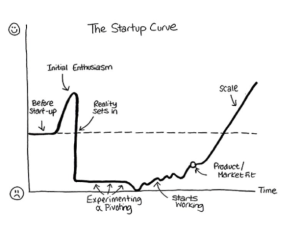PRODUCT ADOPTION CURVE, INNOVATION CURVE
Accelerate your business with these expert tips on "Product Adoption Curve, Innovation Curve". Analyse and discover this TIP!
The Product Adoption Curve, also known as the Innovation Curve, is a concept which describes how consumers adopt and accept a new product or technology over time. This curve is based on the theory of diffusion of innovations developed by Everett Rogers.
The Innovation Curve, also known as the Innovation Adoption Curve, is a a graphical representation showing how a new product or technology is adopted by consumers over time. This curve is a important tool for understanding the acceptance and diffusion of an innovation in the market.
The Product Adoption Curve is represented graphically with the horizontal axis showing time and the vertical axis representing the percentage of product adopters.
The curve shows an S-shaped trend, divided into five key segments
- Innovators: They represent the first group to adopt the product. They are risk-takers, willing to try new ideas and technologies. They are usually a small percentage of the total population.
- Early adopters: They are the second group to adopt the product. They are opinion leaders in their community and have greater social interaction. Their adoption of the product is crucial to attract other consumers.
- Early majority: This group is more sceptical and needs stronger evidence before adopting a new product. Their adoption marks the tipping point towards widespread acceptance.
- Late majority: Represents laggard adopters who join the product after it has been widely accepted. They tend to have less interest in innovation and rely on the experience of others to make purchasing decisions.
- Laggards: They are the last group to adopt the product. They are often resistant to change and may need additional incentives to adopt.
The Product Adoption Curve is important for companies to understand how consumers behave and to plan marketing and product launch strategies. By understanding where their product is on the curve, companies can adapt their strategies to maximise product adoption and success.

Here is a practical example of the Innovation Curve applied to a product:
Suppose a technology company has developed a new wearable device that measures and records users' physical activities.
LET'S SEE HOW THE INNOVATION CURVE WOULD APPLY IN THIS CASE:
- Innovators: At this stage, innovators would be the early adopters. These are people who are interested in the latest technologies and willing to try new products regardless of price. They could be professional athletes, fitness enthusiasts or people who are very interested in tracking their physical activity. They would represent approximately 2-3% of the population.
- Early adopters: As the product becomes known, early adopters would be attracted by its features and benefits. These could be personal trainers, fitness bloggers or social media influencers who share their experience with the device. They would represent approximately 13-15% of the population.
- Early majority: As the product gains popularity and its effectiveness is proven, the early majority would join. These would be health and fitness conscious individuals looking for a tool to help them stay active and improve their performance. They would represent approximately 34-36% of the population.
- Late majority: As the product becomes more common and accepted, the late majority would start to adopt it. These people might be less enthusiastic about fitness but are attracted by the positive opinions and experiences of other users. They would represent approximately 34-36% of the population.
- Laggards: Laggards would be the last group to adopt the product. They are people who may be sceptical towards new technologies or simply not interested in tracking their physical activity. They would represent approximately 10-15% of the population.
As the product moves along the Innovation Curve, the company must adapt its marketing and communication strategies to reach each segment of adopters effectively. This involves target innovators and early adopters through niche channels and more innovative marketing approaches, and then expand visibility and build trust with the early and late majority through testimonials, reviews and hands-on demonstrations.
Over time, the company seeks to achieve mass adoption as the product becomes part of the mainstream and the curve flattens. This requires a broader focus and wider product availability in retail shops, as well as a strong marketing strategy to reach the laggards and overcome any resistance to change.
This is just a practical example of how the Innovation Curve could be applied to a product. The exact shape of the curve and the distribution of the segments may vary from product to product and industry to industry.
The Innovation Curve serves several purposes:
- Predicting adoption: It allows companies to predict and estimate how their product or technology will be adopted in the market. By understanding how consumers adopt innovations, companies can plan more effective marketing and sales strategies.
- Identify market segments: The innovation curve shows how different consumer groups adopt an innovation at different times. This allows companies to identify early adopters and laggards, which helps them to focus their marketing efforts more efficiently.
- Determine market entry strategies: The innovation curve helps companies determine when and how to bring their product or technology to market. They can decide whether to focus initially on innovators and early adopters, or to wait for the early or late majority to join the mass adoption.
- Assessing competence: By analysing the Innovation Curve, companies can assess how their product compares to competitors in terms of adoption and market share. This allows them to identify opportunities to differentiate themselves and develop more effective competitive strategies.
- Set sales expectations: The Innovation Curve provides a general idea of how product sales are expected to evolve over time. This helps companies set realistic expectations and plan their operations and resources accordingly.
In summary, the Innovation Curve is a valuable tool for understanding and predicting the adoption of an innovation in the market. It helps companies make informed decisions on marketing strategies, product development and market entry, which can lead to greater success in the introduction of new technologies or products.
ARTIFICIAL INTELLIGENCE CAN HELP YOU USE THE INNOVATION CURVE TO ACCELERATE YOUR BUSINESS IN THE FOLLOWING WAYS:
- Market analysis: You can provide information about your company and your product or service and it can help you analyse the target market and determine at which stage of the Innovation Curve your product is at. This will give you an idea of current and potential demand, as well as the market segments most likely to adopt your innovation.
- Market entry strategies: Based on your product's position on the Innovation Curve, artificial intelligence can help you develop effective market entry strategies. This includes identifying the most receptive consumer groups, determining the right distribution channels, and setting pricing and promotions that drive early adoption.
- Competitive differentiation: Artificial intelligence can help you identify ways to differentiate your product or service from the competition based on the Innovation Curve. This involves identifying unique features, offering added value or targeting specific market segments that have not yet fully embraced innovation.
- Marketing strategies: With the information provided on the Innovation Curve, artificial intelligence can help you develop more effective marketing strategies. This includes creating persuasive messages for different consumer groups, selecting appropriate communication channels and planning promotional campaigns that generate awareness and accelerate product adoption.
- Sales forecast: Using the Innovation Curve and other relevant data, artificial intelligence can help you make more accurate sales forecasts. This will allow you to set realistic targets, allocate resources appropriately and plan your business growth more effectively.
Remember that it is an artificial intelligence tool and can provide information and suggestions based on its training and knowledge. It is always It is advisable to complement their help with human expertise and additional research to make informed decisions and tailor strategies to your specific situation.
APPLY THIS TIP TO YOUR PROJECT
TASK
CASE STUDY
Name: Ana Rodríguez
Profile of the entrepreneur: Ana is an ambitious and passionate entrepreneur with an educational technology startup that offers an online platform for language learning. Her company is at an early stage and has experienced steady growth, but Ana is looking for ways to accelerate her business and achieve wider adoption of her product.
Objective: Using the Innovation Curve, Ana seeks to accelerate her business and increase the adoption of her language learning platform in the target market.
STRATEGY BASED ON THE INNOVATION CURVE:
INNOVATORS' STAGE:
- Ana identifies innovators, those who are willing to try new technologies and learning methods, as her initial target market.
- To attract innovators, Ana creates a digital marketing strategy focused on creating awareness of the benefits of her platform and the unique features that differentiate it from other existing products.
- Ana focuses on establishing strategic partnerships with influencers and experts in the field of education to promote her platform and generate positive recommendations.
EARLY ADOPTER STAGE
- Once Ana has captured the attention of innovators, she focuses on the next stage of the Innovation Curve: early adopters.
- Ana offers free pilots and early access to new features to early adopters to generate interest and gain valuable feedback.
- Using the testimonials and positive experiences of early adopters, Ana launches marketing campaigns focused on the credibility and success of these users to attract other early adopters.
EARLY MAJORITY STAGE
- Once Ana has achieved a solid base of early adopters, she turns to the early majority stage, which is a larger and less innovative segment of the market.
- To accelerate adoption at this stage, Ana focuses on creating an exceptional user experience and ease of use for its platform.
- Ana implements more traditional marketing strategies, such as online advertising and partnerships with educational institutions, to reach a wider audience and build trust in her product.
LATE MAJORITY STAGE
- Once Ana's platform has achieved significant adoption in the early majority, it focuses on the late majority stage, which includes those who are more cautious about adopting new technologies.
- Ana focuses on providing exceptional support and customer service to build confidence in her platform and overcome any resistance to change.
- It implements referral and reward programmes to encourage positive word of mouth and recommendation of its platform to new users.
MEASUREMENT AND ADJUSTMENT
Ana constantly monitors her company's progress and platform adoption by analysing key metrics such as user growth, retention rate and customer satisfaction. As you progress along the Innovate Curve, you will be able toThe company is also adjusting its marketing strategies, improving the user experience and adding new features based on feedback and market needs.
With this strategy based on the Innovation Curve, Ana can accelerate the adoption of her language learning platform and achieve significant growth in her company. However, it is important to note that each case is unique, and Ana will need to adapt her strategy to the specific characteristics of her target market and the needs of her company.
QUIZ
- 💻 PRACTICE with an expert in the next practical webinar.
- 🔎 CONSULT more related TIPs with this same theme.
- 📖 AMPLIA your knowledge by downloading this EBOOK.
THINK ABOUT YOU
- 🚀 IMPULSA your company in the next acceleration programme, ¡book your place now!
- 🥁 PRACTICE with your project in this practical webinar, ¡apply for your place!
- 🌐 CONTACT with other entrepreneurs and companies, ¡register and take part in the next Networking!
THINK ABOUT HELPING OTHERS
- 🤝COLLABORATE as a volunteer: expert, mentor, inverter, awarding, Spreading the word, challenging, innovating, creating a TIP...
- 💬 RECOMMENDS this programme to reach out to more entrepreneurs by Google.
- 👉 SHARE your learning!
- 📲 SEND this TIP 👇









